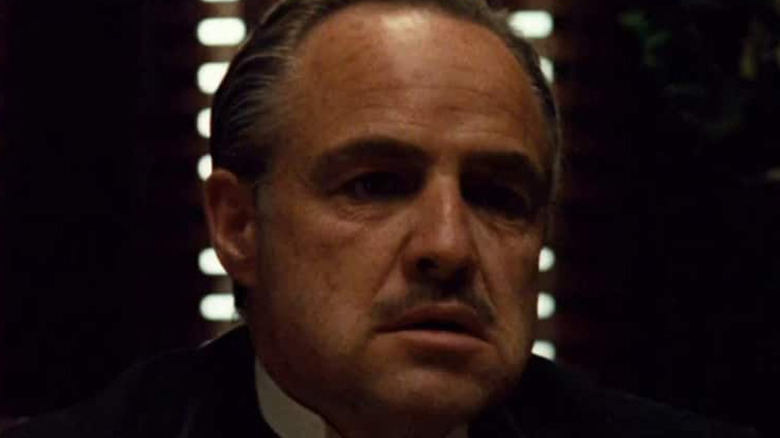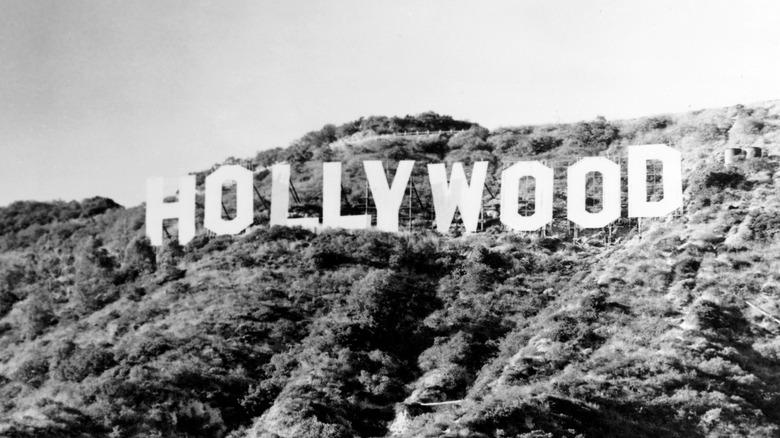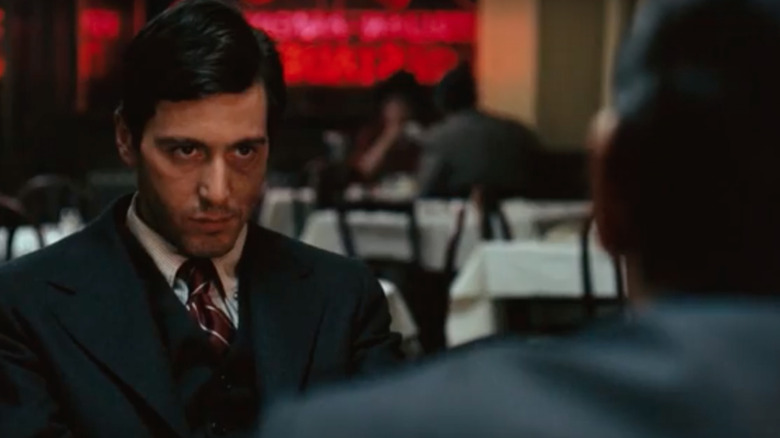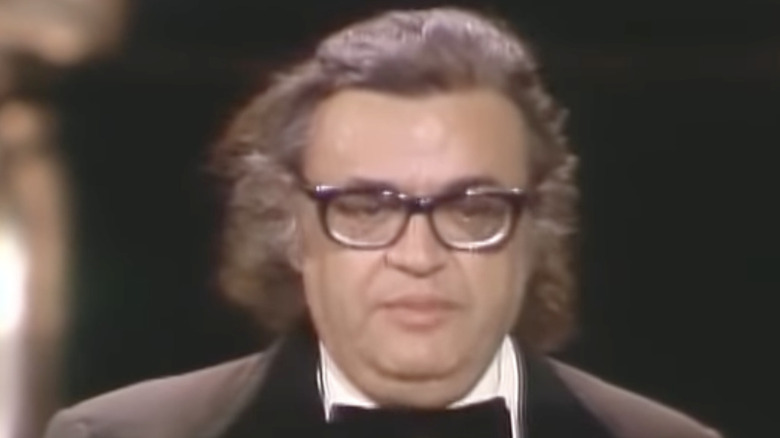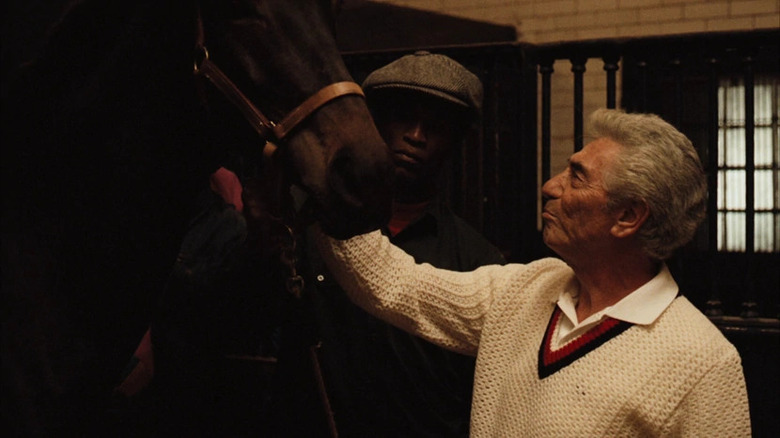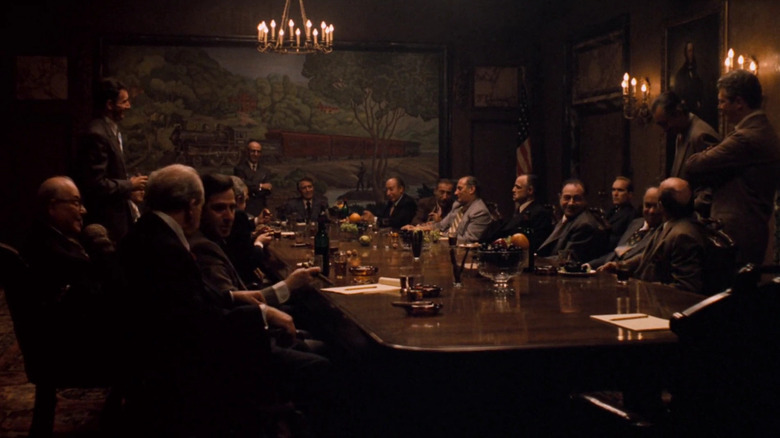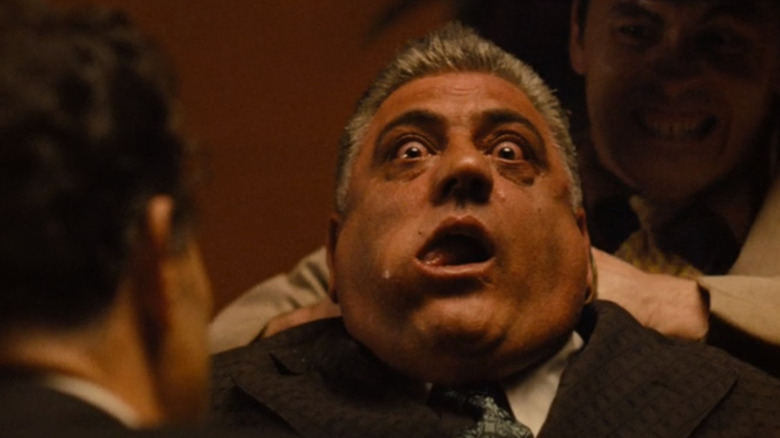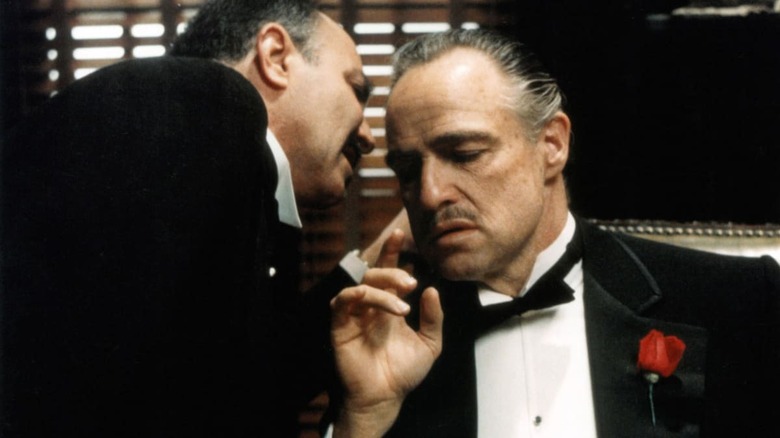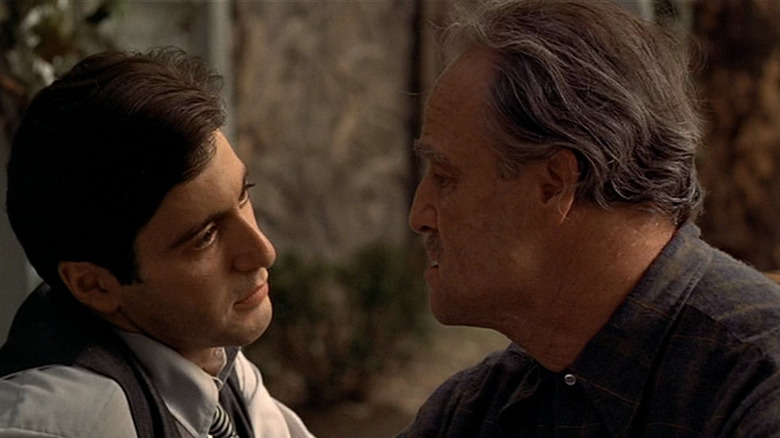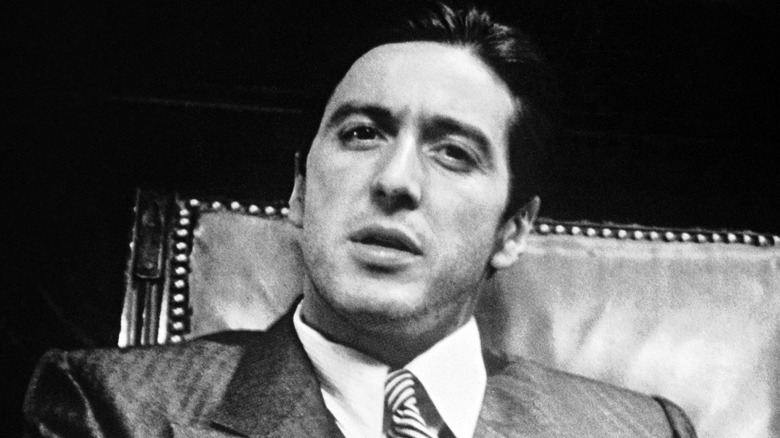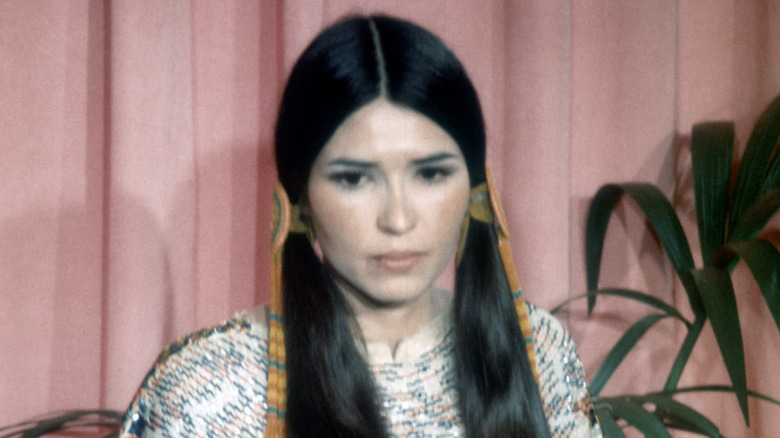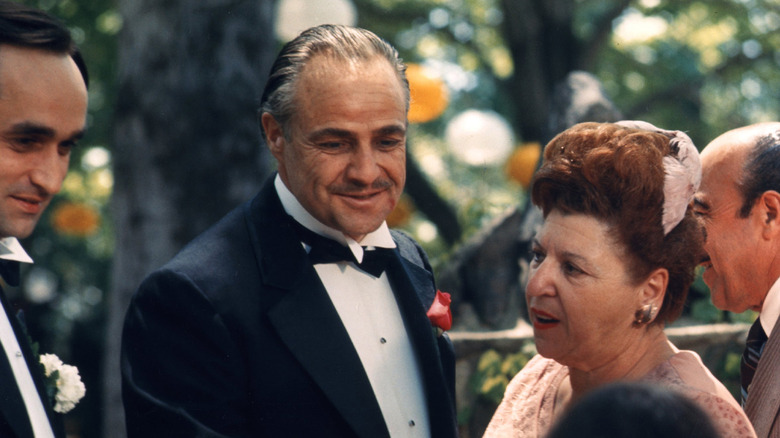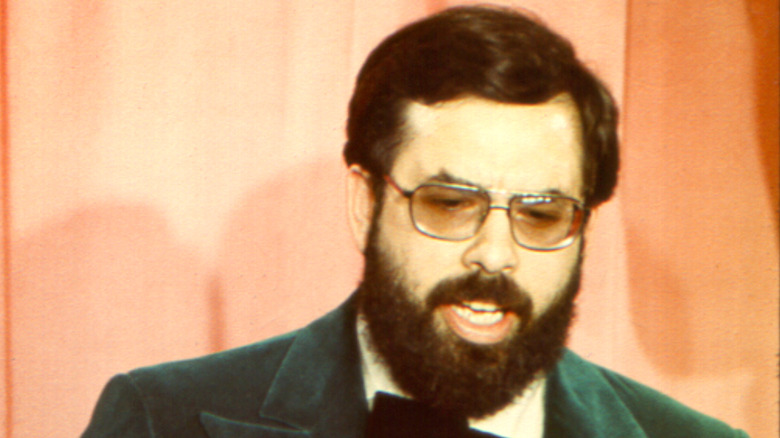What It Was Really Like Seeing The Godfather In 1972
"The Godfather" is a film so legendary that its very name is practically synonymous with the art of cinema itself. The film focuses on the Corleone crime family, led by Don Vito Corleone (played by the incomparable Marlon Brando), whose young son Michael (Al Pacino) embarks on a dark descent into his family's business. This leads to a fair amount of heartbreak, betrayal, and bloodshed along the way.
Since its release, so much has been said and written about Francis Ford Coppola's highly influential adaptation of Mario Puzo's famous novel. Everything from the film's brilliant (and endlessly quotable) script to its engaging performances to its impeccable cinematography has been scrutinized and dissected. In fact, "The Godfather" has been so discussed that it's hard to remember this film wasn't always just seen as a classic or a pinnacle of movie-making. It has been easy to overlook the circumstances surrounding its original release in 1972, from Mafia protests to the changing landscape of American moviegoing behaviors and desires. These are just a few noteworthy aspects to show what it was really like seeing "The Godfather" when it first came out.
Hollywood was in a massive slump
To understand just how pivotal "The Godfather" was, it's important to understand the state of Hollywood in the early '70s. Given the meteoric rise of color television, it was becoming harder and harder to entice large crowds to travel to the movies. So, movie theaters would try various tactics to bring people back, including increasing screen sizes and offering 3-D glasses (via NPR). Despite these gimmicks, the desires of filmgoers were changing. The era of high-budget studio projects were on their way out, in favor of lower-budget, youthful indie films instead.
This change in viewing patterns can also be attributed to the sizable amount of social and political developments brewing in late '60s and early '70s America. The Vietnam War, Civil Rights Movement, and new era of women's liberation (or second-wave feminism) all occurred at this time, causing audiences and filmmakers alike to reconsider what they wanted to see on-screen (via Critics at Large). Against this transitional backdrop, Hollywood would itself go through a massive metamorphosis following the success of a few key films. These successes included the likes of "The Godfather," "The Exorcist," and "Jaws" — all released within a few short years, from 1972 – 1975 (via PBS). Soon enough, the '70s would give rise to the trend of big budget blockbuster movies helmed by fresh new creatives.
Its production caused a corporate rift
Leading up to its 1972 theatrical release, "The Godfather" was already making headlines ... but not for the reasons you might suspect. The film's production was in the crosshairs of the Italian American Civil Rights League, a group looking to combat Italian-American stereotypes (via The NY Times). The Italian American Civil Rights League asked that terms like "Mafia" and "Cosa Nostra" be removed from the script, as they could promote an "anti-Italian" sentiment. "The Godfather" producer, Al Ruddy, agreed to these changes, since courting favor with this group was paramount to filming several key sequences on Staten Island (via The NY Times).
Besides altering the film's language, Al Ruddy offered another olive branch to the Italian American Civil Rights League in the form of a sizable donation: Any proceeds from the film's December world premiere would be donated to the League's hospital fund. However, this kind gesture ended up creating its own complications. Gulf & Western, Paramount's parent company, wasn't actually aware of this arrangement until Ruddy publicly announced it and in fact, Ruddy didn't have the ability to authorize giving away the film's profits. This caused immense tension between Paramount Pictures, who supported Al Ruddy's decision, and Gulf & Western.
The book was already a smash hit
Prior to the film's release, "The Godfather" was already a name on many people's lips due to the success of Mario Puzo's 1969 book of the same name. Puzo was a mostly unknown author and pulp magazine writer, who wrote "The Godfather" for surprisingly cynical reasons. In the late '60s, Puzo was coming off of two well-received but only moderately profitable books (via The NY Post). His son, Tony, has noted that Puzo's frequent spending habits were in stark contrast to the small amount he was making off his writing. Desiring a prolonged lifestyle of "first class spending," Puzo began crafting a novel solely for widespread mainstream success. This endeavor resulted in "The Godfather," a nearly 500-page novel about the fictional Corleone crime family.
The timing couldn't be better, as Puzo was desperate for a hit to pay off his debts, and this best-seller suddenly brought him a tidal wave of financial and critical success. Not only did the paperback rights earn Puzo a total of $410,000, but the novel itself would soon become the fastest-selling book in history. This meteoric success garnered the attention of Paramount Pictures, who approached Puzo for a potential film adaptation, which he would co-write with Francis Ford Coppola. This goes to show just how valuable "The Godfather" was long before a single frame of the film was ever even shot.
The horse scene garnered controversy
By far one of the most memorable (and shocking) moments in "The Godfather" is the infamous horse head in the bed scene. It's so visually iconic that everyone from "The Simpsons" to "How I Met Your Mother" have lampooned it. The scene is made all the more shocking when you watch it with the knowledge that the horse head was real!
Although the studio encouraged Coppola to use a fake horse head for the scene, he didn't like the look of the mockup (via Time). On the commentary track for the film's 2001 home release (via The LA Times), Coppola discusses how he opted to use an actual horse head to achieve maximum realism. His team reached out to a slaughterhouse to acquire the head of a horse that was going to be used for dog food. The slaughterhouse agreed to this bizarre transaction, in which they would send the filmmakers the head of this horse that looked like the one in the movie. This decision caused a fair bit of controversy, as animal rights activists believed that the filmmakers had actually killed a horse for the scene.
The Mafia protested the film
While many were highly anticipating the film adaptation of Mario Puzo's novel, ironically, the one group of people who weren't so excited was the Mafia. The Mafia tried to fight production of "The Godfather" from the beginning, starting with the demands of the Italian-American Civil Rights League, which wasn't just an organization dedicated to combating Italian-American stereotypes. The truth is, the Italian-American Civil Rights League was founded by Joe Colombo, one of the head of New York's Five Families. The organization functioned more as a public relations department for the Mafia, and sought to improve the image of Italian mob families (via The Daily News).
In an effort to do damage control on the image of Italian crime families, a bizarre protest took place in Kansas City, where the film premiered to a sold-out crowd...of zero people (via NPR). The Italian-American Unification Council of Greater Kansas City spent $2,500 on ticket purchases to ensure that the film wouldn't be seen by anyone, which led to a profitable but totally empty house. This didn't spoil the party for theater operator Stan Durwood, who was simply happy the film was getting sizable publicity. Just another example of "The Godfather" turning heads and grabbing headlines only a few days into its original theatrical run.
The film upped the ante in terms of on-screen violence
The '70s would see cinema go through many changes, not the least of which was an increase in on-screen violence. People were already seeing a rise in back-to-back horrors on the nightly news, due in no small part to the violent and disturbing images of the Vietnam War. It was clear that due to these real-life societal anxieties, the average consumer of pop culture was becoming harder and harder to shock via fictitious content. Soon enough, however, cinema from the late '60s through the '70s would begin showing its teeth more and more with representations of violence. This became most prevalent in the horror genre (which was helped by the burgeoning grindhouse market), but mainstream films started embracing the change as well.
This is due in part to the success of several blockbuster films, which comprised of various graphic sequences. "The Godfather" was at the helm of this trend, and was soon followed by other box-office favorites like "The Exorcist" and "Jaws." Whereas the latter films showcased more high concept violence — possessed children and killer sharks — "The Godfather" was a bit different. The violence on display in Coppola's film was portrayed very brutally and realistically, without going too over-the-top. "The Godfather," much like its cinematic contemporaries, definitely played a major role in the increase of on-screen violence in mainstream movies.
The film made Marlon Brando popular again
One noteworthy aspect of "The Godfather's" runaway success was how it revitalized the then-struggling career of Marlon Brando. Nowadays, Brando is widely regarded as one of the finest actors to ever grace the silver screen. With that legacy in mind, it might be a bit hard to comprehend a time when he wasn't viewed as a valuable asset. That was the case, however, as when "The Godfather" was in development, Brando was no longer a hot Hollywood commodity (via Vanity Fair). Following a weight increase, multiple onset incidents, and box office disappointments, the once-celebrated actor was far from a desirable lead in the early 1970s.
Paramount Pictures wanted zero part of Brando, and encouraged Coppola to go a different direction in terms of casting. However, the young director was set on casting Brando — much to the chagrin of studio head Robert Evans. Despite being adamant about not acting anymore, Brando's interest was piqued upon hearing that Laurence Olivier was also up for the role. The studio agreed to consider Brando only if he met certain obligations, including taking a reduced rate and putting up a hefty bond to protect the production from his notorious behavior. Finally, Coppola was allowed to bring Brando in for a screen test, which he had to conduct in a bit of a clandestine and unorthodox way since Brando would have been insulted to do a test. Coppola's strategy worked: Brando began his transformation into Don Corleone, and the rest is history.
The film was perfect for a very cynical America
Oftentimes, the cultural and political climate will have a profound effect on the way a film is perceived. The America of the late '60s and early '70s leading up to the release of "The Godfather" was an eclectic blend of both technological and social change. Thanks to things like the Vietnam War and Watergate Scandal, many young people had grown disenchanted with the government and other societal institutions (via The Conversation). Ultimately, the youth of the era sought to upset the established order, and often went against the values and beliefs of previous generations.
This ever-widening generational gap served as the perfect cultural backdrop for the theatrical release of "The Godfather." The narrative of the film is heavily predicated on an idealistic young person, Michael, trying his best to restructure his father's problematic methods. Over the course of the film, we see Michael struggle to avoid succumbing to the darkness and corruption of his family's business. Sadly, by the final act, his idealism is pushed aside, which results in him becoming a brutal leader like his father. It's an extremely fitting conclusion that lines up perfectly with the heavily present generational gap and cynicism of the '70s.
It introduced the world to Al Pacino
The success of "The Godfather" wasn't just limited to the box office or awards; the power of the film also kickstarted Al Pacino's career. While the young actor had been on-screen in a few roles prior, this was the film that truly supercharged his burgeoning career. The character of Michael Corleone has become so synonymous with Pacino that it's nearly impossible to imagine anyone else in the role. That was definitely Coppola's mindset, as the young director had imagined Pacino as Michael even while reading Puzo's novel, which Coppola explains in a profile on Pacino for The New York Times.
In the same profile, Pacino also mentions that since he was early in his career, he didn't really have any choice but to say yes, even though it took some time for him to get interested in the project. Pacino did eventually recognize the importance of what was being offered to him, since the book was already immensely popular. The casting decision definitely paid off, with Pacino's performance being a huge standout element for many critics. The role immediately propelled Pacino's career into the stratosphere, leading to more high-profile gigs and performances. Today, Pacino is a celebrated fixture of Tinseltown due in no small part to his legendary work on "The Godfather."
Brando didn't want to accept his Oscar
Following its release, "The Godfather" went on to be nominated for several major categories at the 45th Academy Awards. This included Francis Ford Coppola being nominated for Best Director and Al Pacino being nominated for Best Supporting Actor. The film won not only Best Picture and Best Adapted Screenplay, but Best Actor for Marlon Brando's portrayal of Don Corleone. A prestigious honor to be sure, which makes it all the more surprising that Brando refused the to accept the award.
Brando was an avid activist and looked to draw some much-needed attention to Hollywood's problematic treatment of Native Americans on the big screen. This culminated in Brando not attending the ceremony and instead, having Native American actress and activist Sacheen Littlefeather attend in his place. This was in response to the standoff between Native Americans and federal marshals at Wounded Knee in 1973, and Littlefeather received ample boos from those in attendance during her speech. Her treatment backstage was no better, but she and Brando were willing to take the risk to do the right thing, even if it shocked people at the time.
Critics went wild for it
If ever there was a tried-and-true example of a critical darling, it would most definitely be "The Godfather." Every publication, from The Hollywood Reporter to The Village Voice to The New Yorker, had endlessly positive things to say about the film. Although The New Yorker's Pauline Kael disliked Puzo's novel, she described the film as a great hybrid of commerce and art. Roger Ebert praised the movie's ability to keep its viewers engrossed over its hefty three-hour runtime. Additionally, Ebert's frequent cinematic cohort Gene Siskel also spoke highly of "The Godfather," citing its intimate peek into the Mafia's secretive world.
Over at The Washington Post, Desson Howe reserved an additional amount of praise for the man at the helm, Francis Ford Coppola, when he reviewed the film for its 25th anniversary. From the acting to the directing to the cinematography, critics had admiration for just about every element of the film, which many continue to celebrate decades after its release.
It became the highest-grossing film of 1972
To say that "The Godfather" was successful at the box office would be a gross understatement, as it easily decimated any expectations the studio had. As described in Mark Seal's "Leave the Gun, Take the Cannoli," the film quickly became one of the first true blockbusters, and in fact, created something totally new: "a work of art that is also a blockbuster." Not only did "The Godfather" dominate on its opening weekend, but it quickly became the highest-grossing film of 1972. As noted by Turner Classic Movies, the film did so well financially that Gulf & Western's rose from 77 cents to $3.30 a share.
This widespread success continues even today, as "The Godfather" received a special big screen re-release for its momentous 50th anniversary in 2022. Despite the film's age and current inconsistent movie theater attendance figures, the re-release still brought in a sizable profit. It's a testament to just how good Coppola's direction is and just how much people love "The Godfather," even 50 years later.
